This post may contain affiliate links. Please see our disclosure policy.
Apple blossom jelly turns the sweet scent of spring into a delightful floral jelly. You can use any edible fruit blossoms in this recipe, and it works just as well with cherry blossoms, peach blossoms, pear blossoms, and crabapple flowers. Enjoy the taste of spring year-round!

Each year, we try our hand at making new flower jellies to bottle up the taste of spring on our pantry shelf. There’s nothing like the taste of fresh, sweet spring flowers topping a warm, toasty biscuit on a cold January day. It reminds you that spring will come again and, for just a moment, transports you back to that magical place.
We have a deliciously fragrant crabapple tree right outside our front door, and the scent is intoxicating in early May. Every year, I mean to transform that luscious fragrance into an apple blossom jelly, but somehow, I miss it year after year. Their bloom period is short, and there’s always so much going on in spring.
This year though, I set my mind to it, catching them as soon as they opened. I made batches from the bright red flowered crabapple tree, as well as several other apple trees in the yard (and even a few cherry trees). It was well worth the wait, and now this one’s on our list for every year!
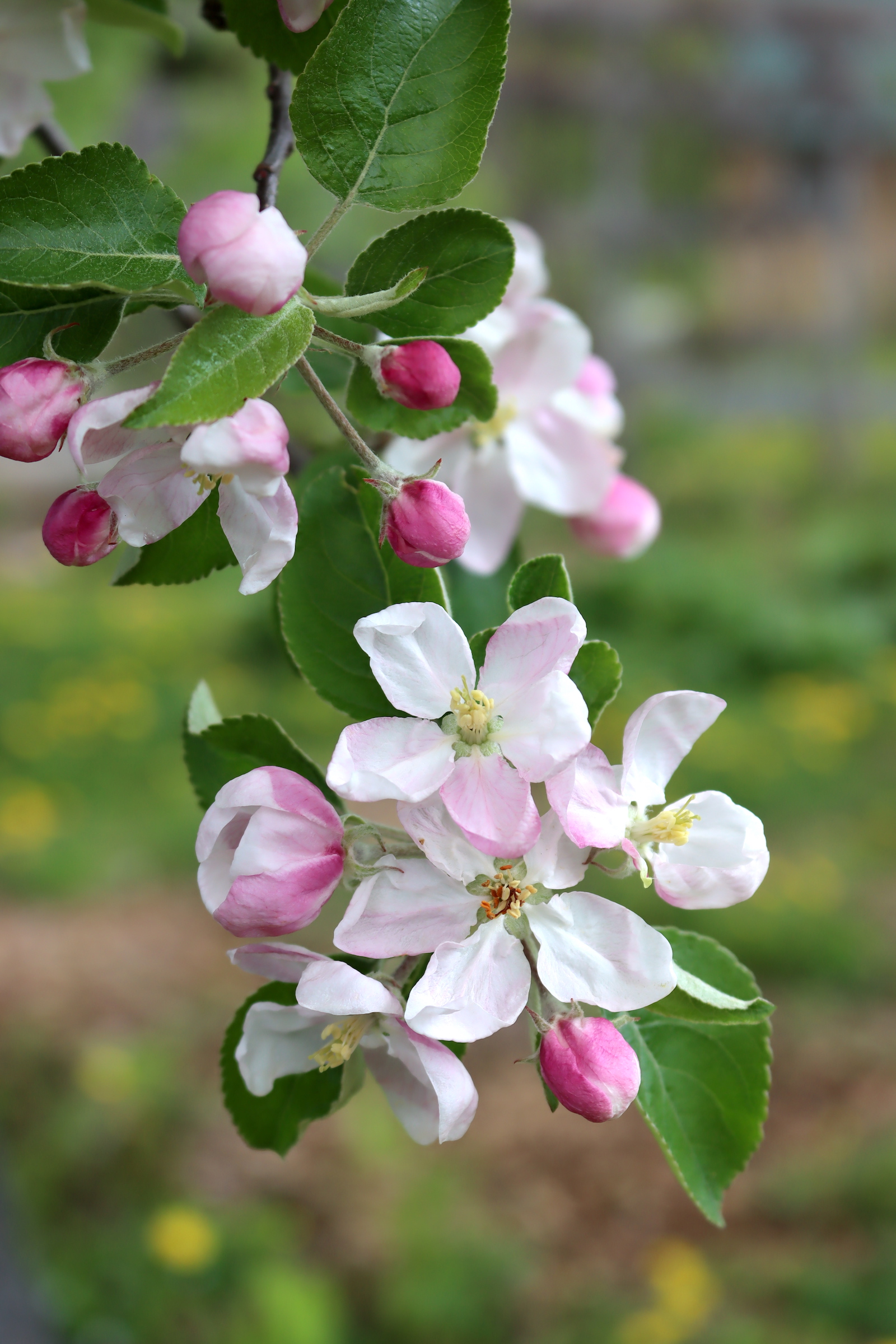
What does Apple Blossom Jelly Taste Like?
Apple blossom jelly tastes more or less like the smell of apple blossoms, which is floral and light, with just a hint of fresh fruit.
The exact flavor depends on the variety of apples (or cherry, or pear, etc.) that you have, as they all have a slightly different fragrance and tastes. Ideally, harvest them when they’re at peak fragrance for the best flavor.
The color varies too, and that also impacts the flavor. Color compounds in the blossoms contain antioxidants, and some of those same compounds are what give blueberries and raspberries their flavor. Depending on the color of your blossoms, the finished jelly might have a slight berry flavor as well!

Harvesting Apple Blossoms For Flower Jelly
So I know what you’re thinking…doesn’t harvesting apple blossoms mean fewer apples?
Nope!
Believe it or not, apples and crabapples (and all other fruit trees) produce way more flowers than they can support to fruit. In orchards, the growers usually watch some portion of the flowers to set fruit (usually no more than 1 in 5 to 1 in 10 blossoms), and then they go through and strip out 3 out of every 4 tiny fruits in early summer to thin the crop.
If you don’t thin the fruit on your apple trees, the fruit you do get will be stunted and about half the normal grocery store size.
From every cluster of blossoms, there should only be, at most, one fruit in the end…but there are usually 5 to 6 flowers per cluster. If you want to be gentle, just carefully harvest a few flowers from each cluster, knowing that the rest will still likely develop into more fruit than the tree should support anyway.
(And then you can thin the young apples later to make unripe apple pectin, but that’s a different story.)
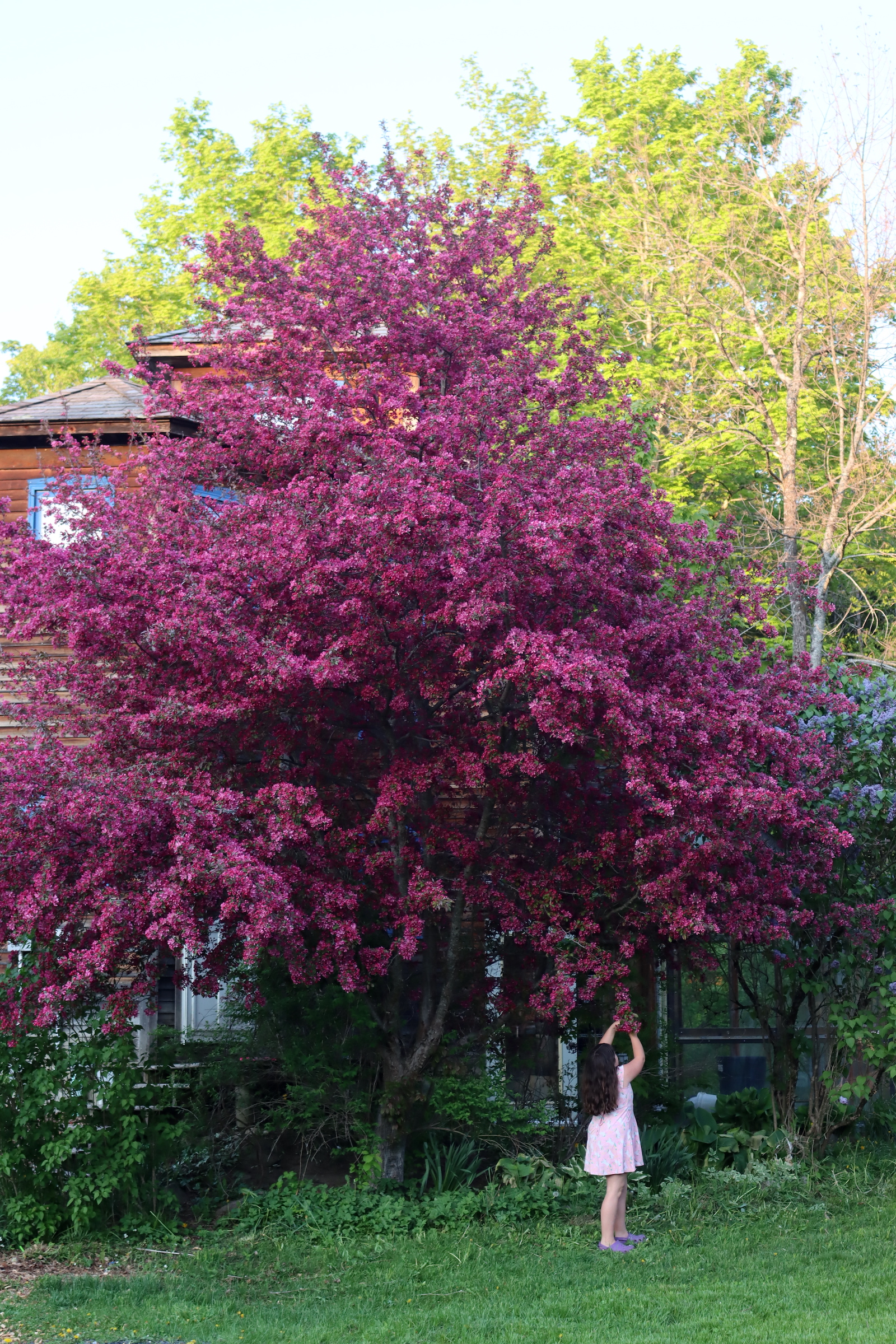
Odds are, if you have a flowering crab, you won’t notice the difference at all. From the millions of blossoms, a few handfuls plucked for a flower jelly are literally a drop in the bucket.
For an extra special batch, you can keep flowers from different trees separate so that you can taste the difference (and see the color difference).
Or you can just mix them and make a “house blend” from your yard.
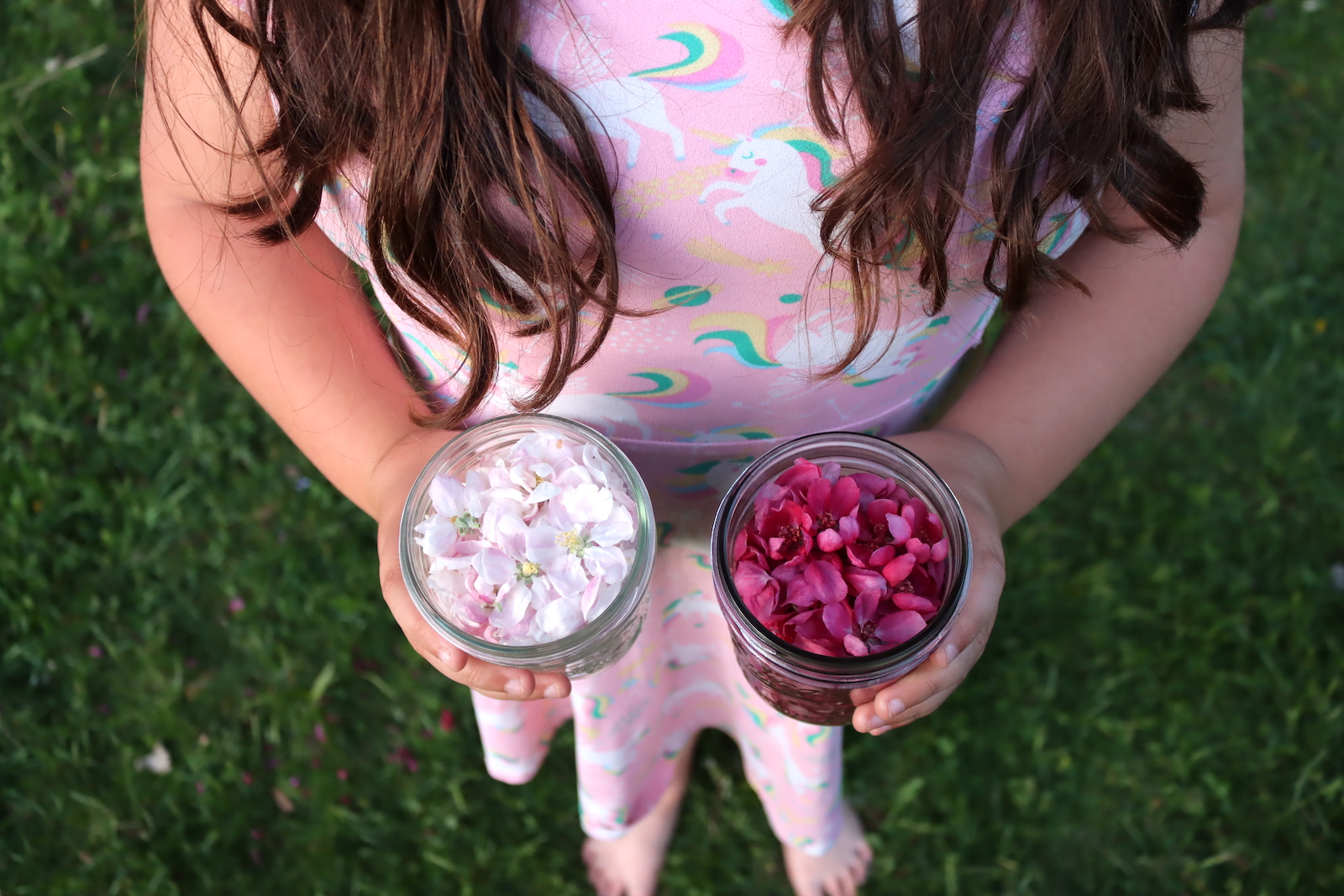
Ingredients for Apple Blossom Jelly
To make a flower jelly from apple flowers (or any edible fruit tree flowers, including peach, pear, cherry or plum), you’ll need freshly harvested blooms, plus water, sugar, pectin, and a bit of lemon juice.
For a 4 to 5 jar batch (8 oz each), you’ll need the following:
- 4 cups Apple blossoms (or peach, pear, cherry, etc)
- 4 cups water
- 2 tbsp lemon juice (or ½ tsp citric acid)
- 1 to 4 cups sugar *see note
- 1 box (1.75 oz) pectin (Regular or Low Sugar)
The scent of your blossoms (as well as their color) will determine the flavor and appearance of your finished flower jelly.
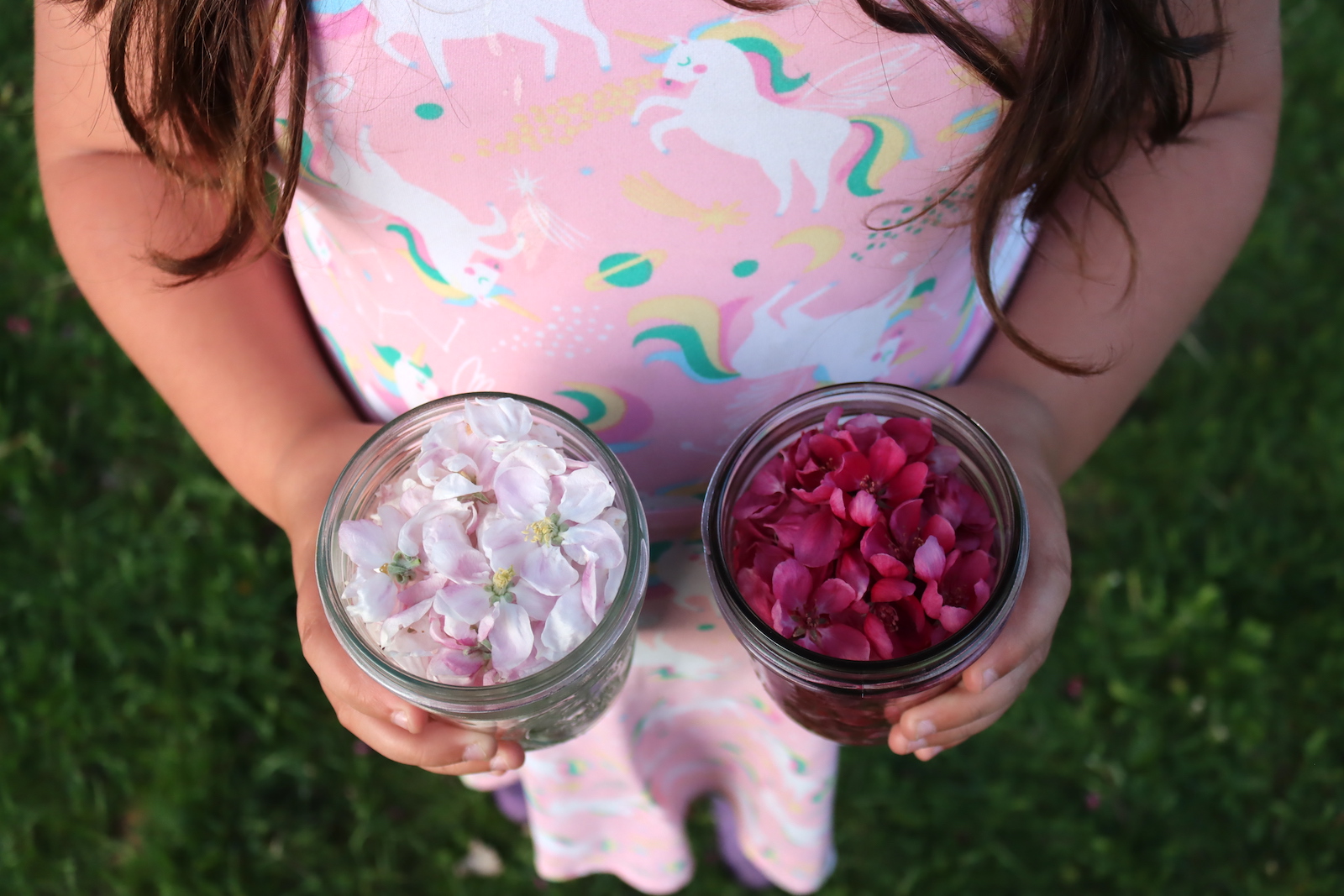
The lemon juice helps balance the flavor of the sugar, adding a bit of tart contrast to bring out the flavor of the flowers. It also lowers the pH, which helps the pectin set, and also preserves the jelly and makes it safe for canning.
Even if you’re not canning the jelly, you do need lemon juice. If you want a more neutral flavor instead, you can use citric acid powder (dissolved in a bit of water).
Citric acid granules are much stronger than citrus juice, and they’re used at a rate of 1/4 teaspoon of citric acid in place of each Tablespoon of lemon juice (or lime juice) in a recipe.
This recipe has 2 Tablespoons of lemon juice, so you’d need 1/2 teaspoon of citric acid per batch.
For pectin, I generally use sure jell or sure jell low sugar pectin, as they’re really dependable and result in the best texture in my opinion. (I’ve tried just about every type of pectin on the market.)
For regular sure jell pectin, you’ll need to add a minimum of 4 cups of sugar because it’ll only jell with a 1:1 liquid to sugar ratio. Sure jell low sugar will gel with any amount of sugar, and you can use as little as 1/2 cup for a barely sweet jelly. I’d suggest using 1 to 2 cups for a lower-sugar recipe that’s still sweet enough.
(Sure jell low sugar can also be used with full sugar recipes, so that’s what I usually keep on my shelf because it works great regardless of the sugar you choose.)
If you have Ball Flex Batch Pectin, you’ll need 6 Tbsp. (which is equal to a 1.75 oz box of other types of pectin). That’s true for their regular and low-sugar canisters.
The recipe card below also has instructions for liquid pectin, which requires astronomical amounts of sugar (7 cups sugar to 4 cups liquid). I don’t use it, but some people prefer that type of pectin, so I’ve included it just in case.
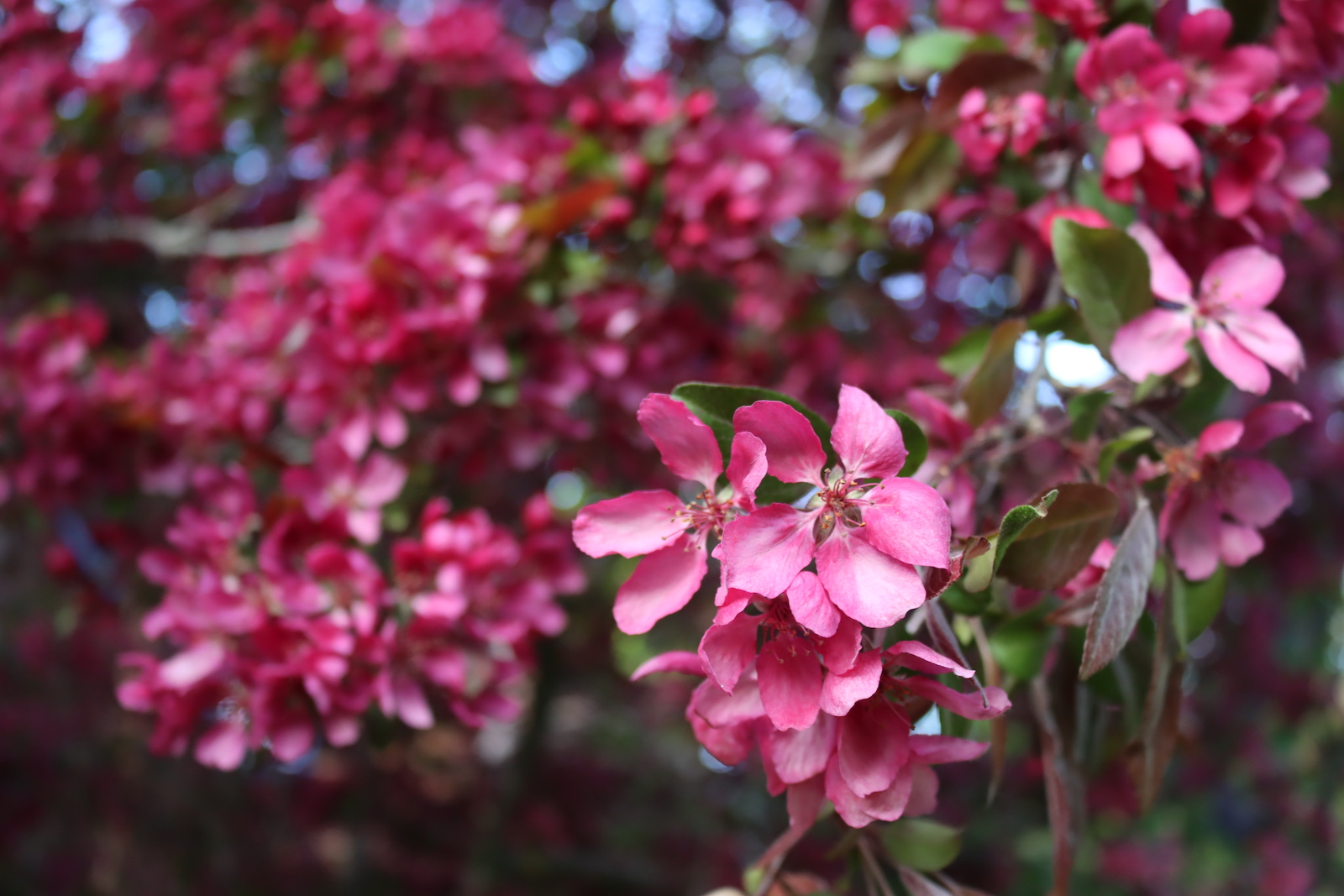
How to Make Apple Blossom Jelly
Making jelly from apple blossoms isn’t all that different from making any type of floral jelly.
You’ll need 2 to 4 cups of fresh blossoms. I like to pick them directly into a quart jar because it’s just the right size for the next step, which is steeping in 4 cups of boiling water.
Steep the apple blossoms for about 15 to 20 minutes, and then strain.
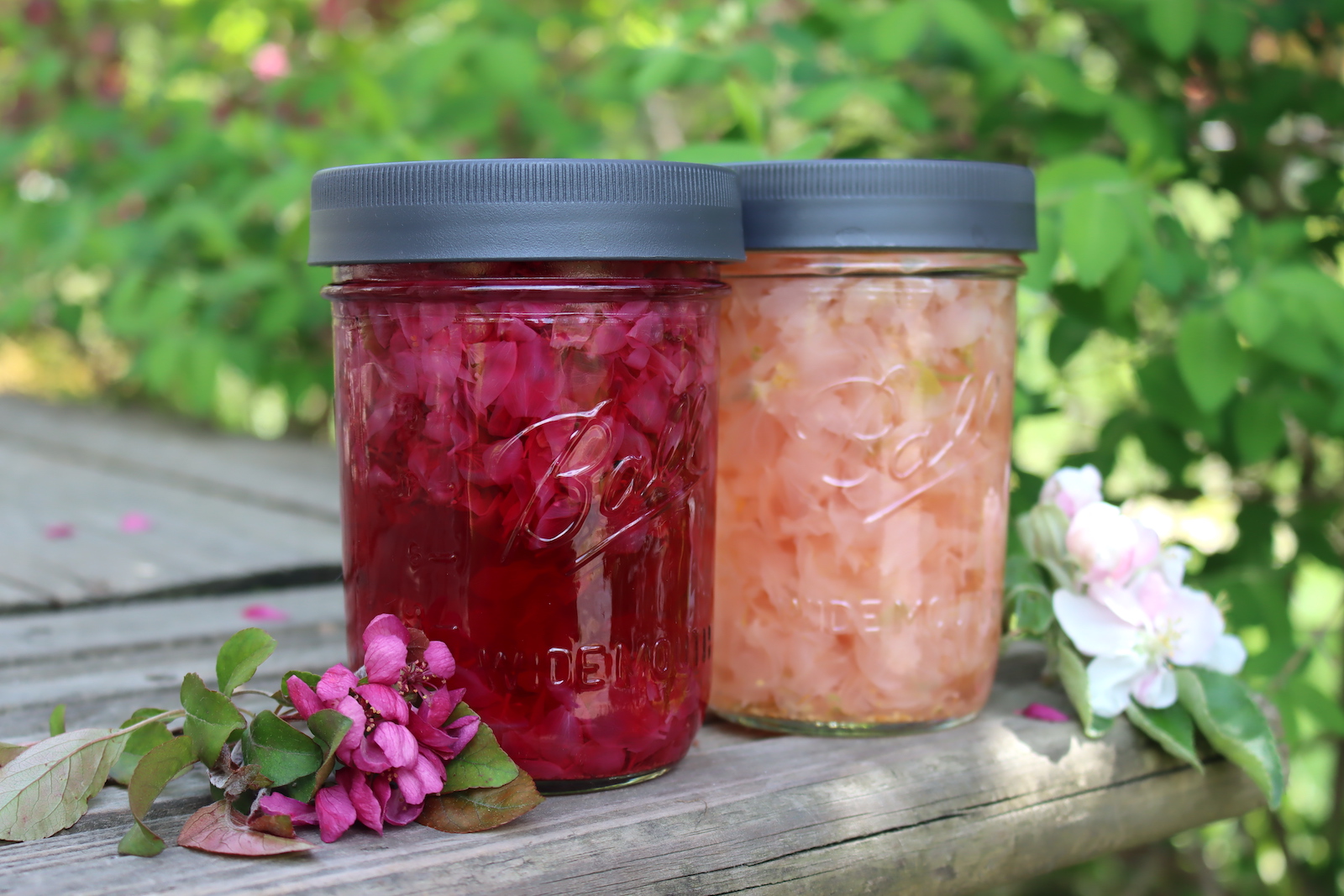
Pour the apple blossom tea into a jelly pot and add 2 tablespoons of lemon juice. (The lemon juice balances the sweetness from the sugar, and also makes the jelly safe for canning. I’d recommend it even if you’re not canning your jelly.) Next, bring the tea to a boil.
Add in one box of powdered pectin. (I use sure jel generally, but any standard 1.75 oz box of pectin will work.)
(You can also make a half batch with just two cups of apple blossom tea, and in that case, you’d use half a box of pectin. A full box is 6 Tbsp, and you can divide it into two batches (3 Tbsp each) as I’ve done, to get two different apple jellies from different trees.)
Stir in the pectin until it’s completely dissolved, and boil for 1 full minute.
Next, add the sugar. Standard pectin requires a 1:1 ratio of sugar to liquid to gel. Since we’re working with 4 cups of apple blossom tea, you’ll need 4 cups of sugar.
If you use a “low sugar” pectin, such as Sure Jel low sugar, then you can use as little sugar as you’d like. For a very low sugar jelly, you can use as little as 1/2 to 1 cup sugar to 4 cups apple blossom tea.
After you’ve added the sugar, stir to completely dissolve and return the mixture to a hard boil on the stove for 1 minute.
After 1 minute, remove the mixture from the heat and ladle it into prepared jars.
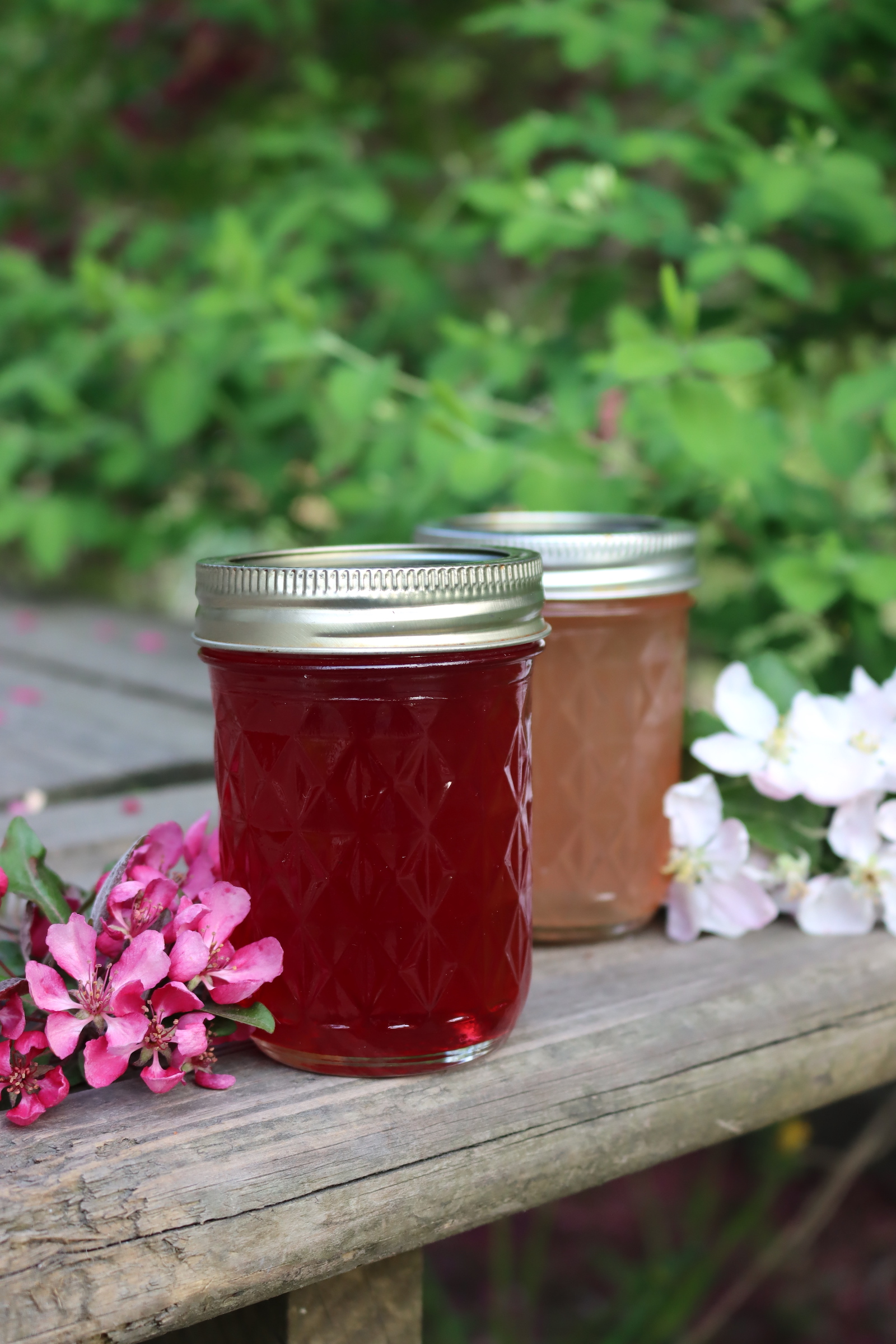
Canning Apple Blossom Jelly
Canning this floral jelly is optional, and you can simply store it in the refrigerator, where it’ll last several weeks. Freezing is also an option, provided you’re using freezer-safe jars.
Personally, I like the simplicity of processing the jars in a water bath canner because it allows me to store the jelly right on the pantry shelf year-round. I can have the sweet, berry-like flavor of apple blossom jelly any time of year, and it’s not taking up refrigerator or freezer space in the meantime.
To can this jelly, be sure you’ve used lemon juice, which lowers the pH of the mixture enough for canning.
Prepare a water bath canner, canning jars, and lids before you start making the jelly. Make the jelly as otherwise, but then ladle into prepared canning jars, leaving 1/4 inch headspace.
Seal the jars with two-part canning lids and process for 10 minutes in a water bath canner (15 minutes if the elevation is above 6,000 feet).
Once the canning time is complete, remove the jars to cool on a towel on the counter. Properly canned and sealed jars will maintain quality on the pantry shelf for 12-18 months. Refrigerate after opening.
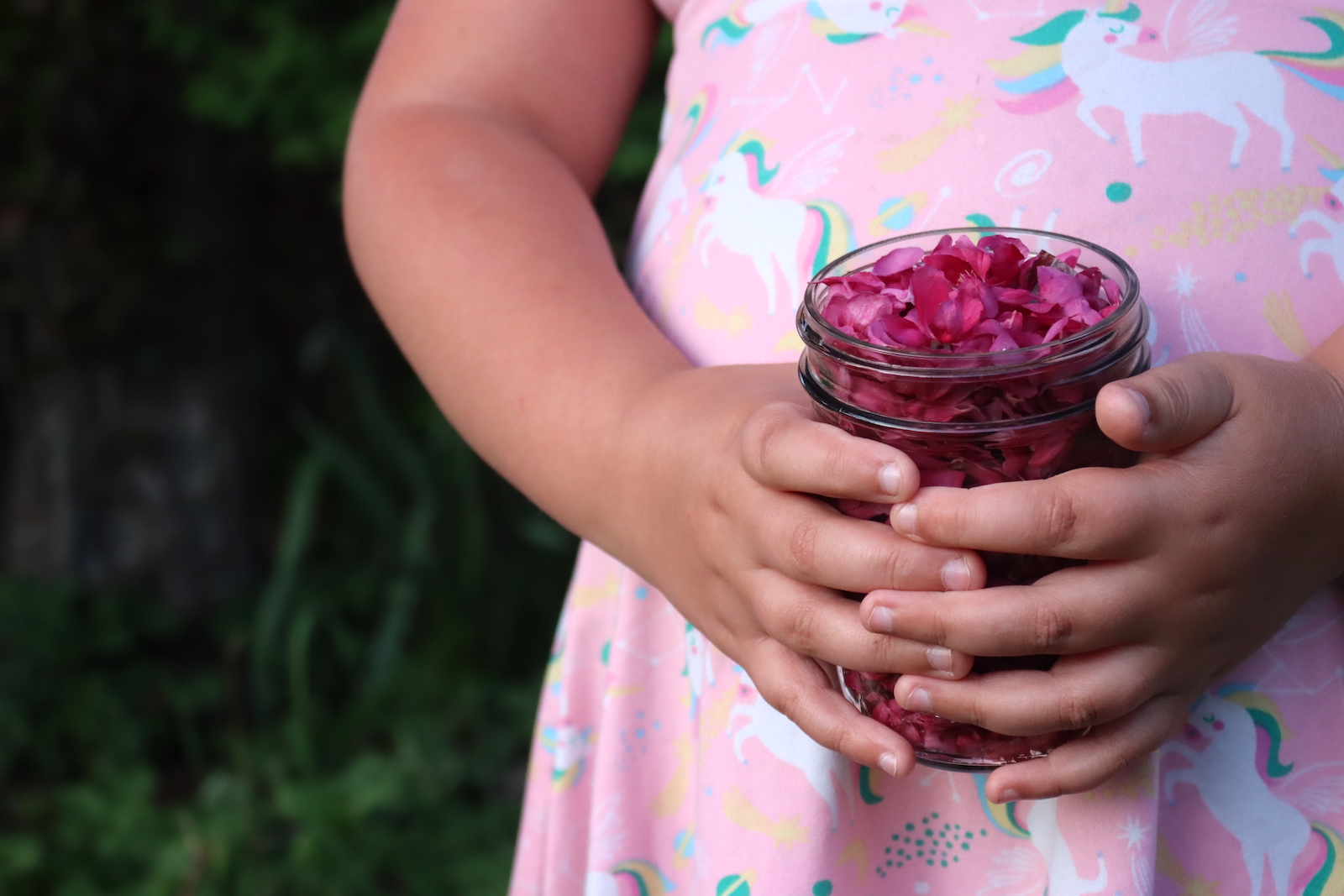
Apple Blossom Jelly Variations
Your choice of fruit tree blossom will dictate the final flavor of your floral jelly, but you can also add in a few things to get a different flavor.
Muddling in a few berries will bring out the berry flavor of the jelly (and give you great color). Raspberries or blackberries are good choices.
You can also use other edible flowers, like dandelion petals (for a honey-like flavor), wild violet petals (for a more berry flavor and a bright magenta color), or lilac blossoms for a more pronounced floral flavor.
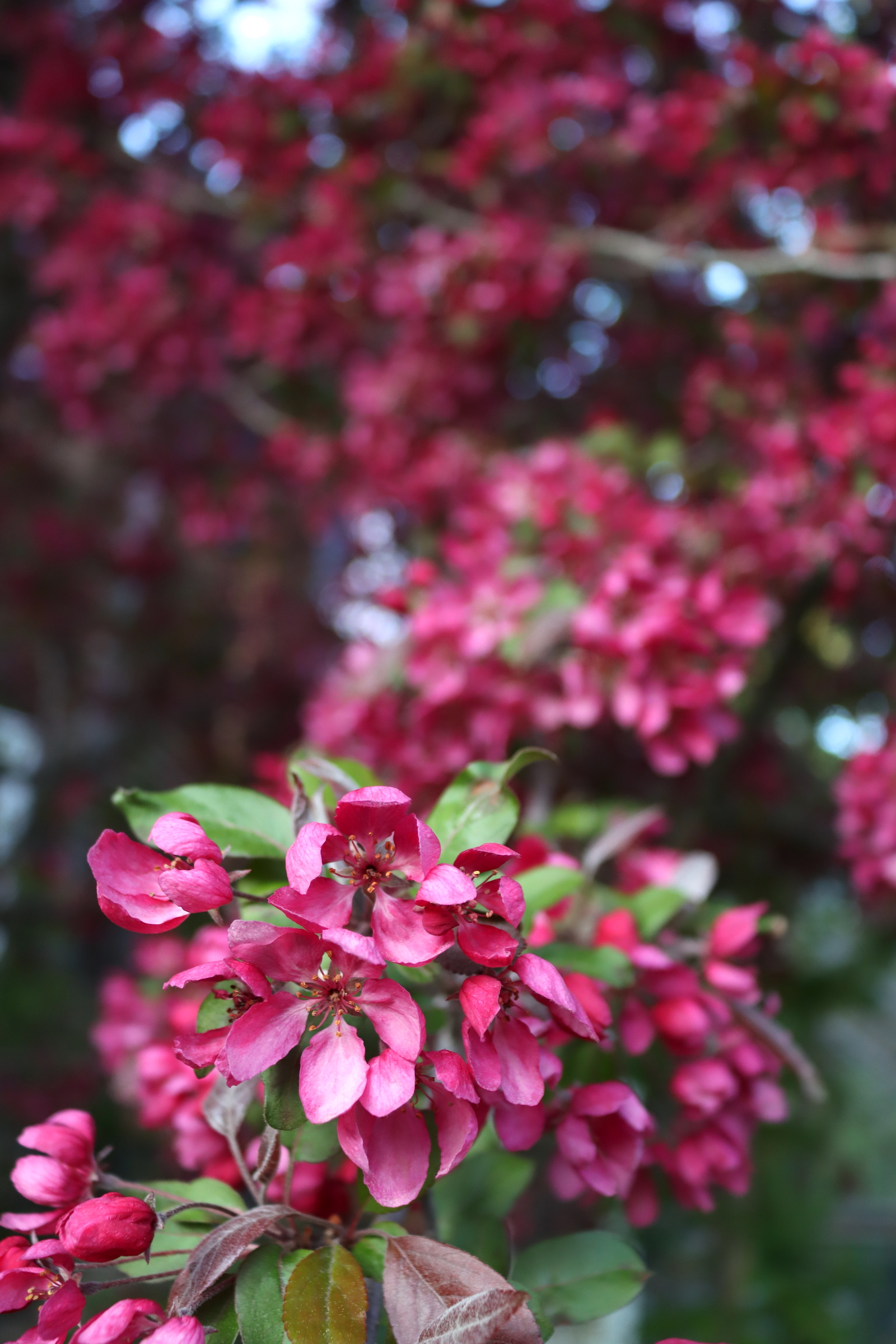
Fruit Tree Blossom Recipes
Looking for more ways to use fragrant fruit tree blossoms in season?
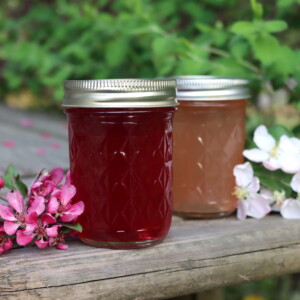
Apple Blossom Jelly
Ingredients
- 4 cups apple blossoms
- 4 cups water
- 2 tbsp lemon juice
- 1 to 4 cup sugar, see note
- 1 box powdered pectin, 1.75 oz pectin (Regular or Low Sugar)
Instructions
- Separate 4 cups of apple blossoms from their stems.
- Pour 4 cups boiling water over the top of the apple blossoms and allow the tea to infuse for about 15 to 20 minutes.
- Strain the floral tea into a saucepan or jam pot. Add the lemon juice, which will help bring out the best color in the jelly, but it's also required to balance the sugar in the recipe and help the pectin set. Beyond that, it adds acidity to help preserve the jelly, so don't skip the lemon!
- Bring the mixture to a boil and add the powdered pectin, stirring to dissolve. Allow the mixture to boil for 1 minute before adding sugar. (Note: Do not add the sugar at the same time as the pectin, or before the pectin, or the jell will not set.)
- Add the sugar, stirring to dissolve (See notes on quantity). Bring the mixture back to a full boil for 1 minute before ladling into jelly jars leaving 1/4 inch headspace.
- If canning, process in a water bath canner for 10 minutes (or 15 minutes if above 6,000 feet in elevation). Otherwise, allow the jars to cool completely on the counter before storing them in the refrigerator (for up to a month) or the freezer for up to 6 months.
Notes
A note on sugar...
If using standard pectin, you must use a 1:1 ratio of liquid to sugar. That means for 4 cups flower blossom tea you'd need a minimum of 4 cups sugar to get the jelly to set. That results in a very sweet "old-fashioned" jelly. To reduce the sugar, simply use low-sugar pectin instead and then make the jelly as instructed but using less sugar. I suggest sure jel low sugar, which is very dependable. Lowering sugar will also lower yield, and the yield of 5 half-pints is for a full sugar recipe. If using Pomona's Universal Pectin, the instructions are different, as that is a 2-part low sugar pectin. Follow the instructions provided in the Pomona's box for mint jelly. If using liquid pectin, the order of operations is different (pectin is added last, sugar first). Liquid pectin also requires a lot more sugar to set (7 cups sugar to 4 cups liquid). I don't recommend liquid pectin because of the high sugar levels required for set, but it will work if that's your preference. If you have Ball Flex Batch Pectin, you’ll need 6 Tbsp. (which is equal to a 1.75 oz box of other types of pectin). That’s true for their regular and low-sugar canisters.Nutrition
Nutrition information is automatically calculated, so should only be used as an approximation.
Flower Jelly Recipes
Stock your pantry with these tasty floral jellies!
- Peony Jelly
- Dandelion Jelly
- Lilac Jelly
- Violet Jelly
- Rose Petal Jelly
- Elderflower Jelly
- Forsythia Jelly
Herbal Jellies
Flowers aren’t the only plants in the garden that make wonderful jellies!
- Savory Herbal Jelly
- Lemon Balm Jelly
- Calendula Jelly (Marigold Jelly)
- Mint Jelly (coming soon)
- Tulsi Jelly (coming soon)
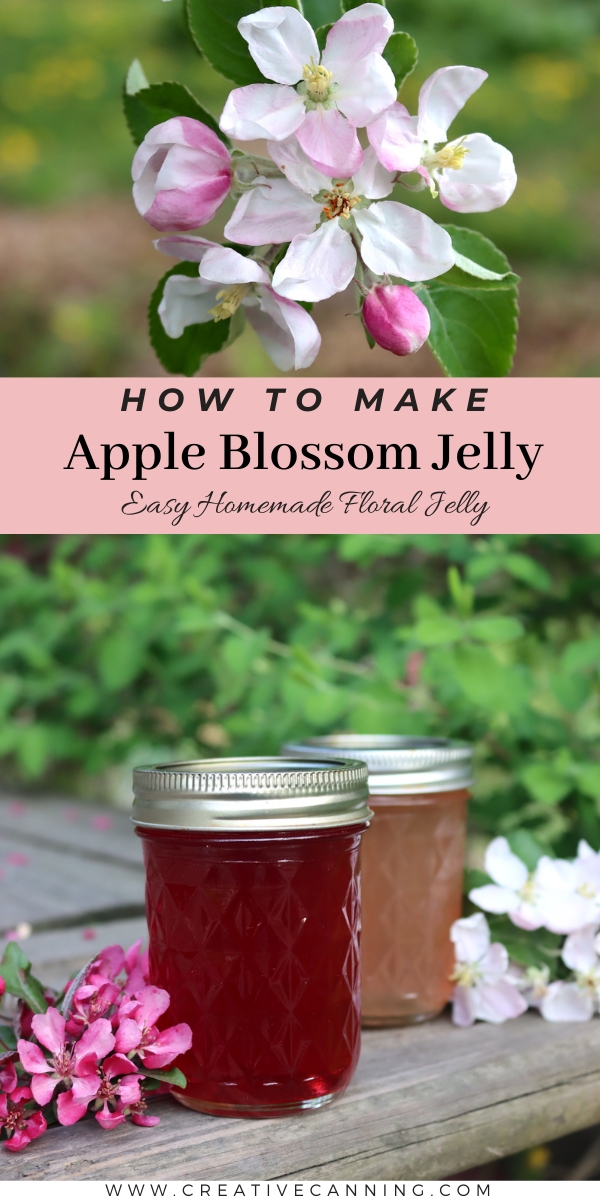
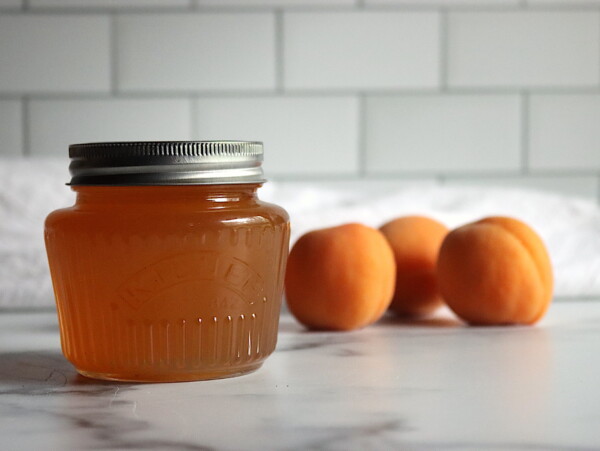
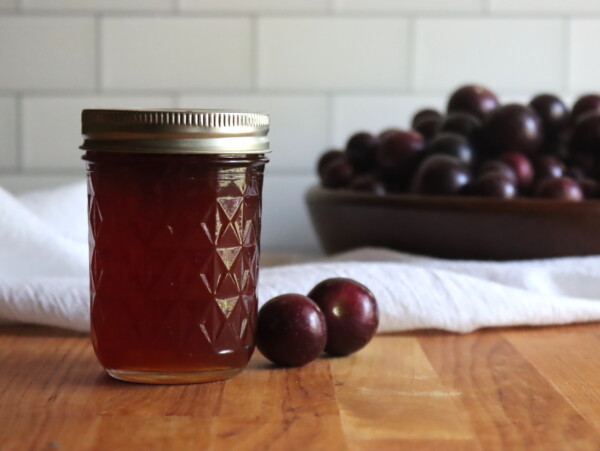
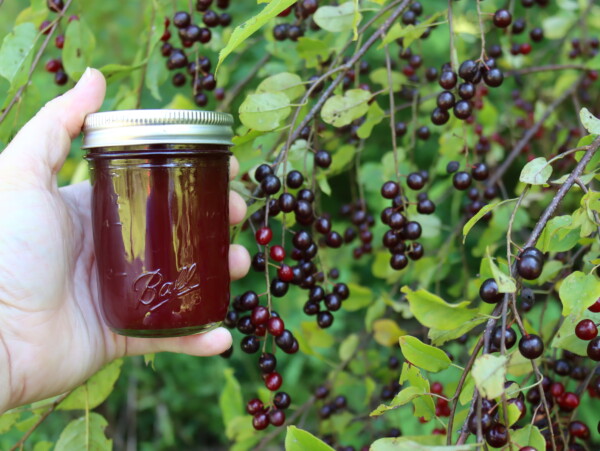
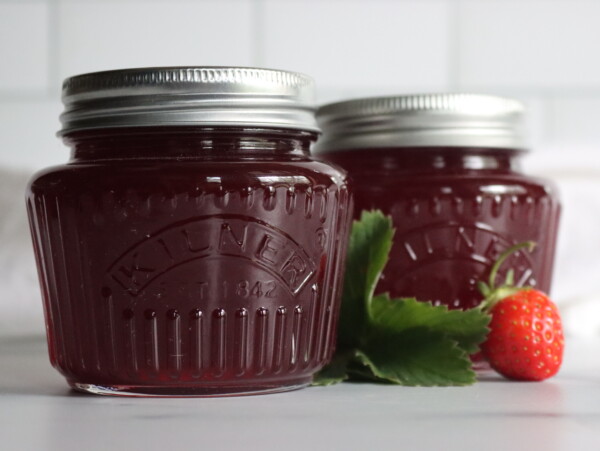
Ohmygawd thank you so much for this recipe!! I made the apple blossom one using 1 cup sugar and two boxes sure jell low sugar pectin and it came out great! I’m curious if this recipe would work with clover blossoms? I’m new to this and your recipe makes it so easy. I also canned the apple blossom jelly. Thank you for your time, Sharon
Yup, you can definitely make this same recipe with clover blossoms. (Our clover is just starting to appear, and I’m planning on a batch myself this year.) Enjoy!
This can be used with pear tree blossom too right? If so what is that flavor similar to?
Yes, you can use pear blossom. Make a tea with a few of the blossoms and sweeten it, that’ll give you some idea as to the taste. Each variety of pear will taste slightly different.